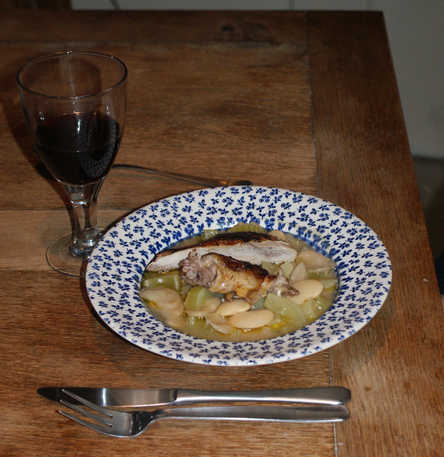
Anuschkurries

Anuschka bought me the curry book that doesn't exist for her birthday. (I know - don't even try to make sense of that.) And I volunteered to make her any recipe she chose from it.
She picked the slightly long-winded but very tasty tandoori chicken kebabs which I finally got around to making for her and her son Willy today.
Fortunately I had some extra tandoori paste leftover from another meal, so it simplified the preparation slightly, but I still needed to get the chicken marinating on Thursday night to give it a good 48 hours to season.
Since I was up anyway I reduced some khoya whilst jointing the chicken, (you get just enough time to skin and de-bone a chicken thigh or leg before the milk starts to stick) and used it to make some kulfi for our dessert.
I wasn't really pleased with it to be honest, although the taste was good, the texture was very dense and heavy. (Though oddly it seemed lighter when it warmed up again!) Also the khoya seemed lumpier than I remembered. Whether that was down to not stirring often enough (read continuously!) or whether I need to stir through some cream at the end as several other recipes do I'm not sure.
Anuschka is terrified of hot spices (does that make it odd for her to buy me a curry book?) so I made a (fairly) gentle saag paneer side dish. 5½/10 Also I've never done much mushroom currying, so I fancied trying out a very mild coconut mushroom curry: coconut milk and mushrooms - what's not to like? meh! Well, it sounds a lot more tasty than it turns out.
I used the whey from my homemade paneer and some of the leftover coconut milk as liquid for the basmati rice, and that was extremely tasty - so the mushroom dish wasn't a complete loss!
I'd make the chicken again, and maybe try and spice up the saag paneer, but the kulfi definitely needs work and I don't think I'd bother with the mushrooms.
In fact I've been dabbling with another creamy mushroom curry to have with the leftovers (together with a banana chutney which didn't make it to the first meal) that seems more promising.
It did cross my mind to wonder if Anuschka had bought me the cookbook in expectation of my volunteering to cook her some tasty curries from it, but Aline assures me that Anuschka just wouldn't be that devious.
I'm not convinced though - she's a woman after all.
Banana Chutney
sauce pickle veg vegan
I was impressed with this chutney at David Bann's after
Mum and I had it with her meal there.
I wanted to have a go at it myself, but wasn't quite sure about the waitresses' instructions on how to ferment the bananas,
so I emailed David for some more details and he very kindly sent this reply:
And here's my first attempt...
And here's my first attempt...
Makes plenty for 4
Ingredients
- 1 red chilli, deseeded and chopped
- 2 bananas, sliced
- 2 teaspoons sugar
- 1 teaspoon curry powder
- juice of 1 lime or maybe try less
- ½ cup water or as required
Dry-roast some aromatic spices (coriander, cardamom, cumin and fennel seeds for example) then grind them to a powder.
Or just use some curry powder you made earlier.
Add the sugar, lime juice, sliced bananas, chopped chilli and enough water to cover.
Simmer gently for about 5 minutes until the banana just begins to break up. Add more water if necessary.
Saag Paneer
Spinach and Curd Cheese Curry
Spinach and Curd Cheese Curry
curry side veg cheese
Spinach and curd cheese Indian curry
I finally got around to trying something from this
Reza Mahammad cookbook I got as a Christmas present from Mum.
About 10 years ago!.
Reza warns about the rubbery fried cubes of cheese he often suffers in restaurants, and suggests grating shop-bought block paneer rather than chopping it to avoid that particular horror.
I, of course, made my own. Which is too soft to grate but crumbles nicely when chopped up.
Plus you get to use the whey to make your rice.
Reza warns about the rubbery fried cubes of cheese he often suffers in restaurants, and suggests grating shop-bought block paneer rather than chopping it to avoid that particular horror.
I, of course, made my own. Which is too soft to grate but crumbles nicely when chopped up.
Plus you get to use the whey to make your rice.
Serves 4
Ingredients
- 450g/1 lb spinach, blanched and chopped
- 1 tbsp vegetable oil
- 2 tsps whole cumin seeds
- 1 medium onion, finely chopped
- 2 garlic cloves, finely chopped or 3
- a pinch of turmeric
- 100g/3½ oz paneer, crumbled or coarsely grated
- 100ml/3½ fl oz vegetable stock
- salt
- 50ml/1¾ fl oz fresh cream
- 1 tbsp fresh coriander, finely chopped
Wash the spinach in plenty of cold water, letting any sand sink to the bottom, then rinse and drain well in a colander.
Put in a large pan, cover with a lid, and place on a medium heat for 2-3 minutes.
The spinach will cook in the steam made by the water clinging to its leaves.
As soon as it begins to wilt, stir the top leaves to the bottom.
As soon as all the leaves are wilted, remove the pan from the heat and drain, squeezing out as much liquid as possible.
Allow the spinach to cool, press out the remaining liquid to get the spinach as dry as possible, and roughly chop.
Heat the oil in a saucepan until hot, then add the cumin seeds and allow them to sizzle. Now add the onion and cook until it becomes translucent in colour. Add the garlic and continue to cook until the onions have softened, then add the turmeric. Stir the spinach into the mixture, continue to cook for a further couple of minutes, then add the paneer and vegetable stock. Adjust the seasoning, pour the cream on to the saag paneer, garnish with the coriander, and serve immediately.
Heat the oil in a saucepan until hot, then add the cumin seeds and allow them to sizzle. Now add the onion and cook until it becomes translucent in colour. Add the garlic and continue to cook until the onions have softened, then add the turmeric. Stir the spinach into the mixture, continue to cook for a further couple of minutes, then add the paneer and vegetable stock. Adjust the seasoning, pour the cream on to the saag paneer, garnish with the coriander, and serve immediately.
Not bad. A bit underwhelming though. Maybe more spice?
Shrove Thursday

Pancake what-day?
Well - Annick thinks it's Pancake Thursday, so that's what we're going for this year. Snot the same without kids anyhow. Unless you count Flora :)
Annick organised a Breton pancake party, which seem to be the same things as crêpes to me. Which is to say, pancakes which are cooked with their toppings in the frying pan at the end.
Annick had prepared a vast selection of cheeses, ham, tomatoes, cooked onions and mushrooms to choose from. And that was just for the savoury course.
She'd also gotten some goose eggs (or really big duck eggs) from a local farm so we had a couple of our pancakes with a sunny-side-up massive fried egg on top. They were absolutely delicious. And massive. With massive yolks
Apparently it's common in Brittany to have an egg cooked miroir on top of your crêpe (or rather galette - if you're using buckwheat), but you'd need astonishingly thin pancakes for that to work, and a normal-sized egg too. So we fried ours separately.
Did I mention how big the eggs were?
Massive.
Hardly necessary for me to bring some extra toppings then, but I did anyway.
For one thing I've been wanting to invent something combining chocolate and mushrooms and this seemed like a good opportunity.
For another I quite fancied some prawns and I know that Annick has a horror of all maritime comestibles. Which is a bit sad for a sailor.
For pudding pancakes we had Nutella, strawberries, bananas, lemon juice and sugar to choose amongst.
Not surprisingly few of us made it to pudding!
Annick went to the trouble of adding the toppings to the pancakes in the pan and cooking them there for a while - I quite like the way this melts the toppings into the pancakes, particularly the cheese. It's nice to have the sugar actually dissolved into the lemon juice rather than just crunching against your fillings, but it's quite a bit more faff.
I can't see it catching on.
Mushrooms in Chocolate Sauce
side sauce ingredient veg
I've been thinking about combining chocolate and mushrooms for a while now,
and making a pancake filling seemed as good an opportunity as any to develop the idea.
I must admit I did spot this version on the intertubes, but I didn't fancy the red wine much, so I had a go at a whiter, cream-based gloopy version. Though I'm wondering if it might be better to do without the onion.
I must admit I did spot this version on the intertubes, but I didn't fancy the red wine much, so I had a go at a whiter, cream-based gloopy version. Though I'm wondering if it might be better to do without the onion.
Serves 4
Ingredients
- butter or olive oil
- 1 onion, chopped
- 4 cloves garlic, roughly chopped
- a pinch of hot chilli powder optional
- about 2 cups chicken stock or whatever stock you have to hand
- ½ cup Madeira
- 2 tablespoons double cream
- 1 dried Ancho chilli or 1 teaspoon Ancho chilli powder
- half-dozen mushrooms I used chestnut mushrooms
- 10-15g very dark chocolate, grated
- butter
- parsley for garnish
Sweat the onions and garlic until they soften without colouring. Add a pinch of chilli powder if you fancy some extra heat.
Add the stock with the whole Ancho chilli and simmer until the onions start to collapse - about 15 minutes. Chicken stock thickens the sauce more effectively, but a nice vegetable stock enriched with Marmite also worked.
Strain back in to the pan, add back the (cleaned) chilli, and reduce to about ½ cup.
Add the Madeira and reduce until it thickens to a coating consistency, leaving about 2 tablespoons.
Remove the chilli, and strain again if any of its seeds have escaped.
Remove from the heat, add the cream, then whisk in the grated chocolate (I used some 100% cacao for this).
Keep warm.
Wipe the mushrooms and quarter them, or slice them fatly. Fry quickly in a little butter until they brown nicely, mix with the sauce and garnish with chopped parsley.
Add the stock with the whole Ancho chilli and simmer until the onions start to collapse - about 15 minutes. Chicken stock thickens the sauce more effectively, but a nice vegetable stock enriched with Marmite also worked.
Strain back in to the pan, add back the (cleaned) chilli, and reduce to about ½ cup.
Add the Madeira and reduce until it thickens to a coating consistency, leaving about 2 tablespoons.
Remove the chilli, and strain again if any of its seeds have escaped.
Remove from the heat, add the cream, then whisk in the grated chocolate (I used some 100% cacao for this).
Keep warm.
Wipe the mushrooms and quarter them, or slice them fatly. Fry quickly in a little butter until they brown nicely, mix with the sauce and garnish with chopped parsley.
Delicious. And well received. Even by the ladies!
First time around I blended up the onion and garlic with the liquids, and the flavour was very good but I didn't like the texture too much.
I think it's better to strain them out and simply reduce the stock and Madeira to thicken the sauce.
If you wanted to serve it as a side dish, rather than a pancake filling, you should just quarter the mushrooms. And I can testify that they go well with steak and potatoes. Probably chips too.
You need a little bit of chilli bite, but not too much, so adjust your chilli choices accordingly.
Using a whole chilli worked out about right heat-wise, but Ancho chilli powder needs a little extra kick.
I guess you could take or leave the cream.
First time around I blended up the onion and garlic with the liquids, and the flavour was very good but I didn't like the texture too much.
I think it's better to strain them out and simply reduce the stock and Madeira to thicken the sauce.
If you wanted to serve it as a side dish, rather than a pancake filling, you should just quarter the mushrooms. And I can testify that they go well with steak and potatoes. Probably chips too.
You need a little bit of chilli bite, but not too much, so adjust your chilli choices accordingly.
Using a whole chilli worked out about right heat-wise, but Ancho chilli powder needs a little extra kick.
I guess you could take or leave the cream.
Pheasolia

Well, it's the end of pheasant shooting season, so last chance for that game dinner I'd promised Flora.
She reckoned she could get pheasant from her hunting people (ah, to have hunting people!), and I promised to cook what they shot, but it seems either they have really bad aim, or are greedier than expected, and Flora ended up buying her pheasant from the butcher like a plebeian.
It's all the same to the chef I guess.
I had some difficulty deciding how best to cook it though - ideally I would attempt to channel Keith Floyd whilst making a long slow pot-roast with red wine and pig's trotters, but this being a Thursday evening, and seeing as how Flora is actually bringing the pheasant with her and expecting dinner sometime tonight that isn't feasible.
So I decided to try a poaching approach instead - based around my Mum's Fasolia which I thought would complement the pheasant nicely.
A Pheasolia if you will.
It worked quite well I thought.
I made up some apple mashed potato to go with, but to be honest it made it awkward to eat. I think bread would have worked better. What about apple bread?
I was in two minds about whether to add some chorizo to the beans, and throw in some parsley to finish, but in the end I forgot about the parsley and decided to skip the chorizo to see how it came out pure.
In any case I had plenty of leftovers so I fried up some chorizo slices and threw them into it when I reheated it to try the best of both worlds. I even remembered the parsley this time!
The leftover mash made a really good leftover stew thickener, and the result was extremely tasty. I'm not sure which I preferred to be honest, it's a deeper, darker, richer stew with the chorizo, but on the other hand I quite liked the lemony freshness of my original.
You pays yer money, you makes yer choice.
Pheasant Poached in a Butterbean Stew
main fowl stew
Pheasant poached in a butterbean and celery stew
A sort of pheasant Fasolia
Serves 4
Ingredients
- 1 pheasant or 2 if you're hungry and have a big pot
- 1 lb butter beans or whatever beans you fancy
- 2 heads celery
- 1 (500ml) bottle dry cider
- Calvados
- chicken or game stock
- chorizo optional
- parsley optional
Soak the beans overnight, if you want to speed up the cooking process.
Make up some celery stock: simmer a chopped head of celery and a chopped onion until the vegetables soften. Then strain out the stock.
Meanwhile, bring the beans just to the boiling point in a large pot of water, skim away the scum, then drain and rinse the beans in cold water. Put them back in the pot, add a few bay leaves, a pinch or two of thyme leaves, a bottle (500ml) of cider and push in the pheasant. Cover with celery stock and chicken stock, if you have any. Bring to the boil, covered, and simmer gently with the lid slightly open to concentrate the flavours.
Simmer for about 45 minutes, then remove the pheasant and set it aside to cool.
Leave the beans simmering, give them a taste and season them if they need it.
When the beans are softened (maybe another 15 minutes), add about half their volume of celery in fat slices - most of a head. Continue to cook until the celery is soft: 20-30 minutes.
Meanwhile separate the pheasant legs and breasts. Cut between the thigh and breast, pull the leg away until the joint pops then cut it free.
Slice along the breastbone to free the breast, then cut around it prying gently with your fingers: the breast should come away whole.
Heat a generous amount of butter in a wide frying pan, add a little olive oil (to help stop the burning) and quickly brown up the legs and breasts (skin still on) on both sides, then pour in a generous measure of calvados, let it bubble away to coat the pheasant, then set the meat aside to rest.
To serve:
Stir a generous dollop of olive oil through the beans to coat them, ladle into bowls, drizzle with lemon juice, place some pieces of pheasant on top (slice them up nicely if you like), pour over any of the calvados deglaze, and eat with some crusty country bread. Or apple mash if you're a masochist.
Make up some celery stock: simmer a chopped head of celery and a chopped onion until the vegetables soften. Then strain out the stock.
Though if you can't be bothered you can just skip the celery stock and use chicken stock. Or water.
Meanwhile, bring the beans just to the boiling point in a large pot of water, skim away the scum, then drain and rinse the beans in cold water. Put them back in the pot, add a few bay leaves, a pinch or two of thyme leaves, a bottle (500ml) of cider and push in the pheasant. Cover with celery stock and chicken stock, if you have any. Bring to the boil, covered, and simmer gently with the lid slightly open to concentrate the flavours.
If you want to add some chorizo slices to the beans you can - it will make deeper, richer stew,
but you'll lose some of the lightness.
Simmer for about 45 minutes, then remove the pheasant and set it aside to cool.
Leave the beans simmering, give them a taste and season them if they need it.
When the beans are softened (maybe another 15 minutes), add about half their volume of celery in fat slices - most of a head. Continue to cook until the celery is soft: 20-30 minutes.
Meanwhile separate the pheasant legs and breasts. Cut between the thigh and breast, pull the leg away until the joint pops then cut it free.
Slice along the breastbone to free the breast, then cut around it prying gently with your fingers: the breast should come away whole.
Heat a generous amount of butter in a wide frying pan, add a little olive oil (to help stop the burning) and quickly brown up the legs and breasts (skin still on) on both sides, then pour in a generous measure of calvados, let it bubble away to coat the pheasant, then set the meat aside to rest.
To serve:
Stir a generous dollop of olive oil through the beans to coat them, ladle into bowls, drizzle with lemon juice, place some pieces of pheasant on top (slice them up nicely if you like), pour over any of the calvados deglaze, and eat with some crusty country bread. Or apple mash if you're a masochist.
A pretty good way to cook the pheasant - I poached mine for an hour, and the legs were perfect,
but I thought the breasts were a little dry. Try poaching for 45 minutes.
I had some parsley ready to stir through the beans at the end, but I forgot to add it. I'm not sure it would have helped, particularly as I made it without chorizo.
I had some parsley ready to stir through the beans at the end, but I forgot to add it. I'm not sure it would have helped, particularly as I made it without chorizo.
Sweet and Sour Flora
Flora texts me to find out what we're having for dinner:
Obviously you can't tell from the context, but I'm pretty sure she was talking about Chinese food.
So to accomodate her simple request I looked out a Sweet and Sour Pork dish, only with chicken. Since I'd already bought a chicken for something else.
I figure that being orange it will bring lots of colour if I serve it hot it will definitely provide the warm and being a main course it should also be pretty savoury (exactly what main courses aren't savoury then Flora?).
I'll leave Flora to provide the sweet which just leaves the healthy for which I pull out a sharp, aromatic Crab and Sweetcorn Soup from Ken Hom to start. It must be healthy - it's a soup right?
As usual when feeding Flora - time is of the essence, fortunately the soup is pretty quick to prepare, especially if you buy the crab prepared (as I did) or tinned.
Job Done.
Obviously you can't tell from the context, but I'm pretty sure she was talking about Chinese food.
So to accomodate her simple request I looked out a Sweet and Sour Pork dish, only with chicken. Since I'd already bought a chicken for something else.
I figure that being orange it will bring lots of colour if I serve it hot it will definitely provide the warm and being a main course it should also be pretty savoury (exactly what main courses aren't savoury then Flora?).
I'll leave Flora to provide the sweet which just leaves the healthy for which I pull out a sharp, aromatic Crab and Sweetcorn Soup from Ken Hom to start. It must be healthy - it's a soup right?
As usual when feeding Flora - time is of the essence, fortunately the soup is pretty quick to prepare, especially if you buy the crab prepared (as I did) or tinned.
Job Done.
Crab and Sweetcorn Soup
soup fish
The white pepper is a critical ingredient, but be careful not to overdo it.
You can substitute ground black pepper if you must.
This doesn't have the lemony flavour nor the toothiness of chicken and sweetcorn soup, but has its own definite sharp and sour character.
This doesn't have the lemony flavour nor the toothiness of chicken and sweetcorn soup, but has its own definite sharp and sour character.
Serves 6
Ingredients
- 1 lb corn on the cob, or 10 oz canned or frozen corn
- 1 egg white
- 1 teaspoon sesame oil
- 5 cups good quality ready-made chicken stock
- 1 tablespoon Shaoxing rice wine or dry sherry
- 1 tablespoon light soy sauce
- 2 teaspoons finely chopped fresh ginger
- 1 teaspoon salt
- ½ teaspoon freshly ground white pepper though you might want to check the taste before adding it all
- 1 teaspoon sugar
- 2 teaspoons cornstarch, blended with 2 teaspoons water
- 8 oz fresh or frozen crabmeat
- 2 tablespoons finely chopped scallions, to garnish
If you are using fresh corn,
peel and wash the cobs, then remove the kernels with a sharp knife or cleaver.
Mix the egg white and sesame oil together in a small bowl or measuring cup and set aside.
Bring the stock to a boil in a large pot and add the corn.
Simmer for 5 minutes, uncovered, then add the rice wine or sherry, light soy sauce, ginger, salt, pepper, sugar, and dribble in the cornstarch mixture.
Bring back to a boil, then lower the heat to a simmer.
Add the crabmeat.
Immediately afterwards, slowly pour in the egg white mixture in a steady stream, stirring slowly all the time.
Transfer the soup to a tureen or individual bowls and garnish with the scallions.
I cooked my corn cobs first, then I roughly puréed about half with some stock to give a bit of texture to the soup.
You should end up with about 1½ cups corn.Mix the egg white and sesame oil together in a small bowl or measuring cup and set aside.
Bring the stock to a boil in a large pot and add the corn.
Simmer for 5 minutes, uncovered, then add the rice wine or sherry, light soy sauce, ginger, salt, pepper, sugar, and dribble in the cornstarch mixture.
Bring back to a boil, then lower the heat to a simmer.
Add the crabmeat.
Immediately afterwards, slowly pour in the egg white mixture in a steady stream, stirring slowly all the time.
Transfer the soup to a tureen or individual bowls and garnish with the scallions.
It's a bit brown-looking, but it tastes really good.
I'm not sure where I'd go to improve it to be honest.
You can also use lobster instead of crab, but the result is nowhere near as good.
Fiesta Peruana

Today one of those painfully earnest middle-class middle-aged knightsbridge women on Radio 4's Woman's Hour taught me how to pronounce quinoa - like the cry of a Tourette's baby: 'kin WAH!.
Useful stuff, and just in time for the latest visit from Aline, my cute landlady, and another excuse for a (distinctly wholemeal) knees-up.
Aline loves to spend her time hanging out in Amazonian tree-tops, and since she's been trapped indoors for many months now writing up her foot-thick doctoral thesis, it's definitely time to break out and Party Party Peruvian Styley!
It's turned out to be our biggest gathering yet - partly 'cos almost everyone we invited actually showed up for a change you know who you all are and partly 'cos we also made it a surprise birthday party for Aline's friend Anuschka not that it stopped us forcing her to skivvy for us in the kitchen. So her friends had to come. Hah!
Twenty three people to feed and water - so we went buffet style, mostly cold food which seems to be quite the Peruvian thing, and just a couple of hot stews: One meat and one of those 'kin WAH things - an Inca favourite. Allegedly.
I played only a minor role in the cooking this time - I catered for the non-vegetarians with a pork adobo and a rack of crackling, I under-cooked some peruvian-style rice to go with, and then busied myself with jugs of Cuban Mojitos to get the cocktails rolling.
OK, not exactly authentically Peruvian, and we had planned on more native Pisco sours, but they're kind of fiddly to prepare and we had only limited amounts of Pisco, so we decided to save those for later when things had relaxed a little and we had some time to ge the food processor out.
Pretty hard stuff to get - Pisco. A kind of Peruvian grape poteen, with a fairly distinctive odor of herbal sweat, it's not widely stocked, though you can order it on the internet for around £25 (promptly delivered too I have to say). Or you can buy it from Harvey Nichols for £105 [Tamaya's Gran Pisco is sadly no longer available there :( ].
You do the math.
The sours went down rather smoothly, when they finally put in their appearance, but I guess the party was pretty much drunk out by that point, because we ended up with half a jug that we just couldn't get rid of, not helped by Jenny's mum Liiisa refusing to have anything to do with them!
So I stuck the leftovers in my ice cream machine's ready-frozen sleeve and put it straight back in the freezer. I thought it might freeze smoothly without needing to be stirred being mostly egg white foam. But I was wrong. The result is a crunchy frozen Pisco mousse. Not awful, but no substitute for ice cream I'm afraid.
My Mojitos, meanwhile, met with almost universal female disapproval. Too sour apparently. I reluctantly muddled in more sugar. Still too sour. So I added a bit more sugar. Then still more sugar. Finally the girls were drinking slightly alcoholic sugar syrup and still complaining, and when we collected all the glasses at the end to wash what did we find at the bottom? Yup - a thick sticky layer of undissolved sugar.
Lady wussies. They should stick to their Baileys!
Still it seems there are advantages to having a party for mostly teetotal, non-smoking, vegetarian, mothers. They didn't completely trash the joint and they all went home at a reasonable time. Dammit - I must be getting old!
Speaking of glasses - how is it that despite laying out a whole stock of paper plates and plastic knives, forks, and cups, every single piece of cutlery and crockery that we own ended up dirty?
I guess we failed to padlock them away!
I was going to make some deep-fried fritter-like things for pudding half-way throught the party, but was overcome by an attack of common sense and for once we ended up making absolutely all of the food in advance.
Bonus!
Here are the few simple dishes we made to entertain the masses:
menu
Cold Courses
Mushroom Ceviche
Haddock Ceviche
Causa Rellana - vegan style
Quinoa Stew
Sweet Potatoes
Boiled sweet corn
Hot Stuff
Adobo de Chancho
Pork Crackling
Peruvian Rice
Pudding
Mazamorra morada
Picarones
Drinks
Pisco Sour
Mojitos
Mushroom Ceviche
Haddock Ceviche
Julia's contribution - and tons of it too!
Causa Rellana - with tuna fishCausa Rellana - vegan style
Quinoa Stew
Sweet Potatoes
Boiled sweet corn
Hot Stuff
Adobo de Chancho
Pork Crackling
Peruvian Rice
Pudding
Mazamorra morada
Picarones
The pudding which never happened.
Birthday Cake
Made using Clare's Gluten-Free Brownie recipe.
Drinks
Pisco Sour
Mojitos
We borrowed a handy bilingual book of Peruvian cuisine from Aline's friend Julia who was also good enough to bring along the haddock ceviche, Which she didn't make following the book. Slightly suspiciously I thought? and Aline did a good job of trawling the web for vegetarian-friendly versions of peruvian classics, making good use of a site called, appropriately enough, Peru Food
And a good time was had by all.
All that's left is for Aline to sober up, bind her massive thesis and get a real job!
Season's Eatings

Yes, once again 'tis the season to stuff your bird and stuff your face.
We like a traditional goose for the Christmas bird in our house; lovely succulent meat, never dry. Plus you get about a year's worth of beautiful fat for your roasties. Anyway, if it was good enough for the Cratchits it's good enough for us!
Following our traditions I picked the stuffing and the starter. I quite liked the sound of Nigella's gingerbread stuffing so we went with that. We were slightly worried that it might turn out too sweet, so we replaced some of the gingerbread with regular bread, but to be honest it was still a bit overwhelmingly sweet and sticky. I think I might go back to something a bit more traditional next year.
Unusually this year we also had a roast duck.
Since my brother decided to have himself a family we are now forced to get dressed (get dressed! On Christmas day! The horror!) and treck the mile upon mile (yes: two miles) to his place for Christmas Dinner. So fearing there wouldn't be enough leftover bird to feed two families for one entire day, Mum and I decided to have a second Christmas dinner at home on Boxing day with a duck. We were taking no chances.
For starters we made up some of Aidan's goats cheese parcels, which seemed to travel well when Aidan brought them around to my place, but unfortunately Mum ignored all my careful instructions on how to cut up the cheese and instead mashed it to paste before I got the chance to stop her. So they were a bit soggier than I had hoped.
main fowl
A couple of things I relearned this Christmas about making gravy:
- If you make sure to keep some water in the bottom of the bird's roasting tin you'll get a nice rich dark stock under the layer of fat to make your gravy with. Without the water you might just end up with a burnt crust and unusably bitter fat.
- Gravy thickens with between 1 and 3 tablespoons of flour fried in an equal volume of fat for each pint of liquid. So a litre of gravy needs 2 tablespoons flour for thin and up to 6 tablespoons for extra thick gravy. If you're using cornstarch then you'll only need about 2 teaspoons per pint.
- You can finish your gravy with a variety of flavours:
- orange juice ideally a mandarin such as satsuma, clementine, or tangerine, lemon juice, or zest from either
- port or red wine, Madeira, Marsala, white wine or even cider probably best used to deglaze the roasting tin
- any other liquor or brandy
- Worcestershire sauce or mushroom ketchup
- mustard
- spices, tomato purée or ketchup possibly best fried with the flour
- redcurrant jelly, jam, or other preserve
- garlic and anchovies apparently!
- marmite or bovril if you're a complete philistine
- a whisk of butter to add a little gloss
- Apparently bird roasting times can actually be dramatically less than the standard 20 minutes per pound recommended by cookery writers since the dawn of time. Felicity Cloake even claims to have cooked a 6kg turkey in just two hours - unlikely as that seems. I have to say though, that the low temperature roasting times for our goose were pretty much as advertised. And we used a meat thermometer and everything.
Ingredients:
It's a bitter-sweet meal - marking as it does the end of Christmas. The delicious end of Christmas.
Nothing left after that but to start working on those leftover mince pies.
Roast Duck
main fowl
Our 6lb duck was just perfect after 2½ hours cooking,
with the last half hour at a slightly higher temperature to crisp it up.
Serves 4
Ingredients
- 1 duck
- herbs, garlic or fruit for stuffing optional
Pre-heat the oven to 220°C/425°F/Gas Mark 7.
Untruss the duck and remove the wing tips (if present).
Prick (or slash) the duck skin all over, at about 1" spacing. Make sure to pierce through the skin into the fat layer, but don't penetrate the bird's flesh. This is to make sure that the fat runs out and leaves the bird with a nice crispy skin, without losing any of the meat juices.
Reduce the heat to 180°C/350°F/Gas Mark 4 after 15 minutes or so once the fat has started to crackle, and cook the bird for about 20 minutes plus 20 minutes per lb, basting every 20 minutes or so if you like, or the skin is looking a bit dark.
You can turn the temperature back up again for 20 minutes at the end to get the skin crispy and golden.
Untruss the duck and remove the wing tips (if present).
Prick (or slash) the duck skin all over, at about 1" spacing. Make sure to pierce through the skin into the fat layer, but don't penetrate the bird's flesh. This is to make sure that the fat runs out and leaves the bird with a nice crispy skin, without losing any of the meat juices.
If you like you can render away more of the excess fat to start with by either steaming the bird over boiling water for half an hour,
or simmering it up for 30 minutes with herbs and vegetables as for making stock.
Pat the bird dry before carrying on with the roasting process.
Rub the skin with salt and pepper and place the duck uncovered, breast up, on a rack over a roasting tin containing a little water (or wine!)
(to stop leaking juices from burning so you can use them to make a nice dark gravy).Pat the bird dry before carrying on with the roasting process.
Reduce the heat to 180°C/350°F/Gas Mark 4 after 15 minutes or so once the fat has started to crackle, and cook the bird for about 20 minutes plus 20 minutes per lb, basting every 20 minutes or so if you like, or the skin is looking a bit dark.
If you like you can turn the bird a couple of times too - we started the bird on it's breast then flipped it onto it's back about halfway
- but I'm not convinced it's necessary.
The bird is ready when the juices run clear when penetrated between thigh and breast
and the temperature of the thickest part of the bird reaches 75°C/165°F.You can turn the temperature back up again for 20 minutes at the end to get the skin crispy and golden.
You don't really want to stuff a duck as it will suck in too much fat, but feel free to throw a handful of herbs,
garlic, tart cherries, orange or lemon rind or pieces into the cavity to infuse a little flavour.
Gingerbread Stuffing
ingredient side
This makes an edible but very sweet, dense, heavy stuffing.
Very sweet.
A bit too sweet if you ask me.
It might be worth trying with regular bread replacing some of the gingerbread, but I think I'll be doing a different stuffing this time next year.
Very sweet.
A bit too sweet if you ask me.
It might be worth trying with regular bread replacing some of the gingerbread, but I think I'll be doing a different stuffing this time next year.
Fills 1 Goose
Ingredients
- 500g (3 medium-sized) onions
- 2 eating apples, peeled and cored
- 45g butter
- 1 x 15ml tablespoon vegetable oil
- 750g streaky bacon
- zest of 2 clementines/satsumas
- 2 x 400g gingerbread loaves (such as McVitie's Jamaica ginger cake), loosely crumbled
- 2 eggs, beaten approx.
- ½ teaspoon freshly ground pepper
Using a food processor or by hand, finely chop the onions and apples.
Put the butter and oil in a large, wide saucepan over a medium heat and fry the chopped onions and apples until soft, about 10-15 minutes.
Finely chop the bacon in the processor, or by hand, and add this to the softened onion and apple mixture. Cook everything, stirring frequently, for about 5 minutes more.
Add the zest of the clementines/satsumas.
Take the pan off the heat and let it cool a little before mixing in the gingerbreadcrumbs. You can let this get properly cold now if you want.
Just before you want to cook the stuffing, add the beaten eggs and pepper,and use it to stuff the cavity of your bird, or cook all of it (or what's left after stuffing your bird) in a buttered baking dish. I don't stuff the bird but put all of my stuffing in a very generously buttered old Le Creuset terrine, with internal dimensions of approx. 25cm x 9cm x 7cm deep.
Bake it in a hot oven (200°C/gas mark 6) with your turkey for about the last 45 minutes. If the stuffing's going into a full oven - which it no doubt is - there should be no need to cover the dish. If the oven is less full, and therefore hotter and less steamy, you could cover with foil for the first 30 minutes.
Let the cooked stuffing sit in its terrine for a good 10 minutes out of the oven before turning it out and slicing it. Or just spoon from the dish if that's less stressful. (I love a slice of this, cold, in a Christmas night or Boxing Day turkey sandwich.)
Put the butter and oil in a large, wide saucepan over a medium heat and fry the chopped onions and apples until soft, about 10-15 minutes.
Finely chop the bacon in the processor, or by hand, and add this to the softened onion and apple mixture. Cook everything, stirring frequently, for about 5 minutes more.
Add the zest of the clementines/satsumas.
Take the pan off the heat and let it cool a little before mixing in the gingerbreadcrumbs. You can let this get properly cold now if you want.
Just before you want to cook the stuffing, add the beaten eggs and pepper,and use it to stuff the cavity of your bird, or cook all of it (or what's left after stuffing your bird) in a buttered baking dish. I don't stuff the bird but put all of my stuffing in a very generously buttered old Le Creuset terrine, with internal dimensions of approx. 25cm x 9cm x 7cm deep.
Bake it in a hot oven (200°C/gas mark 6) with your turkey for about the last 45 minutes. If the stuffing's going into a full oven - which it no doubt is - there should be no need to cover the dish. If the oven is less full, and therefore hotter and less steamy, you could cover with foil for the first 30 minutes.
Let the cooked stuffing sit in its terrine for a good 10 minutes out of the oven before turning it out and slicing it. Or just spoon from the dish if that's less stressful. (I love a slice of this, cold, in a Christmas night or Boxing Day turkey sandwich.)
Sweet and sticky, just like Nigella.
Snowed In Sunday

I Went to visit Doctor Jenny in the arctic wastes of Dundee this weekend.
She's been assiduously trying to lure me up there for weeks now with the promise of fine dining in the Bridgeview Station Restaurant that she's discovered. There may be ulterior motives however - Jenny's new cottage has an AARGA and she's been trying to figure out how to actually use it for anything other than burning toast, so I said I'd bring up something to cook in it.
After she told me some horror stories about roasting a chicken for 6 hours, I decided to make a Raan - since it's already marinated in yoghurt to break down the fibres and soften the meat I figured it would be the most forgiving of time and temperature. Jenny bought an oven thermometer and reckons that here AARGA sits sullenly around 180°C, so I figured a good 3½ hour roasting would do for the joint, plus half an hour R&R (for the joint, not for us. Jenny's not that kind of girl).
AARGAs are funny things. Massive iron blast furnaces of undeterminate and uncontrollable temperatures, Jenny's AARGA started off too hot for the slow cooking of the Leg of Lamb, and ended up too cool to simmer beans. Jenny's AARGA also has only two hobs on top that, though large, are not quite large enough to cook more than half of two pans at the same time.
Since most of my cooking involves frantic last-minute frying that became a bit of a problem, so I had to schedule the hob-work more carefully than usual.
Fortunately keeping things warm is the AARGA's speciality.
On Thursday afternoon I bought a nice leg of lamb from a friendly butcher near my work, having clearly forgotten that legs of lamb are now obscenely expensive. Of course I could have bought a leg sealed into heavy duty plastic bag along with a pint of blood and what looks like semen from a not-so-local supermarket for slightly less, but one does what one can for the remaining independent shops.
I made up a quarter batch of tandoori paste, burnt it whilst frying, threw it away, made up another quarter batch of tandoori paste, then smeared up my Raan and sealed it in about 20 plastic bags before putting it in the boot of my car.
Now my car smells like an Indian takeaway.
I also planned a Kalpna Bainghan Bharta which goes quite well with the leg of lamb, and uses up some of the leftover tandoori paste too. So I puréed up a batch of onions, garlic and ginger to take with me.
You can never be sure what you'll find in Jenny's house.
I figured I'd decide what staple (rice/chapatis/naans) and other dishes I'd make when I got there, and I went for rice (Jenny had a jar of long-grain rice) and a dal (Jenny had a jar of green lentil-pea-things).
We got the lamb in the top oven (uncovered) at 4 o'clock (optimistically announcing dinner for eight), went shopping (Jenny loves shopping), Put the pricked and greased aubergines and onions in the oven about 5:30, got the dal simmering about 6:00 and started frying up the Bharta (which took quite a long time).
I cooked up the rice in some ghee to nicely coat the grains, simmered them covered with twice their quantity of water and a little salt, squeezed onto one of the hobs for five minutes or so until the water had disappeared to the level of rice, then stuck it into the AARGA's warming oven at about 7:15.
The lamb came out to rest at 7:30 (so far so on time!), the augergine and tomatoes went into the bharta and I started frying up the tarka to finish off the dal. Unfortunately after so much cooking effort the poor AARGA had cooled off to tepid, so the tarka took rather longer to caramelize the onions than I had anticipated, and the dal wasn't finished until 8:30. Still, the rice, bharta and raan went onto the table at 8:00 sharp.
Another partial success!
For dessert we used some of the meringues I had left over from Stir-up Sunday (and which I had re-baked to try and dry them out some) to make a messy Eton. And we learned that it isn't a good idea to mix in the meringues too early lest they dissolve completely into the cream and fruit.
Bugger.
We had planned a nice balmy 707 sail on Sunday, so we got up at 7:00 to set off in good time.
We had not planned on finding the first snows of winter piling up on Jenny's doorstep and covering all the land, and we had not planned on getting trapped on a steep icy hill with sliding cars blocking our progress ahead and behind. Eventually after a Landrover appeared and towed the cars out of our way, we gave up and returned to Jenny's for a second breakfast.
So we discovered two things:
- Jenny was wise to have just bought a 4x4 if she ever wants to leave her home in the winter months.
- 4x4 vehicles are not magic, and may still do massive skids narrowly missing trees and drainage ditches if you take icy corners too fast.
Hey - I get my jollies where I can!
Dal
curry side veg
Spicy Indian lentil soup
Here's a Dal I made up from the stuff at the back of Jenny's cupboard.
Obviously you can use any legumes you like, with any spices you like - I fancied the small jar of aniseedy powder I found labelled 5 spices though it wasn't any I recognised.
You can also add any vegetables you like to the lentils (cauliflower, potatoes, tomatoes), use any flavoured liquid (stock, coconut milk, juice, wine), and fry tomato purée with your tarka if you fancy.
There are probably as many Dals in the world as there are lentils.
Ok, pans of lentils.
Obviously you can use any legumes you like, with any spices you like - I fancied the small jar of aniseedy powder I found labelled 5 spices though it wasn't any I recognised.
You can also add any vegetables you like to the lentils (cauliflower, potatoes, tomatoes), use any flavoured liquid (stock, coconut milk, juice, wine), and fry tomato purée with your tarka if you fancy.
There are probably as many Dals in the world as there are lentils.
Ok, pans of lentils.
Serves 8
Ingredients
- 2 cups lentils/beans/peas I used some un-labelled split green peas. Though they might have been green lentils
- 2-3" fresh ginger, peeled, sliced into fat disks
- 2-3 fresh chillies, whole or sliced
- 1 teaspoon turmeric
- 2-3 cloves garlic, peeled, crushed
- ½ teaspoon salt
For the Tarka:- 6 cardamom seeds
- 1 teaspoon cumin seeds
- 1 teaspoon mustard seeds
- 2 onions or equivalent shallots, thinly sliced
- 1 teaspoon that aniseedy mixed-spice powder you found at the back of the cupboard
To Serve:- spoonful or two of yoghurt, or lemon juice, or vinegar
- fresh coriander to serve
Wash your lentils well and pick over to remove any boulders.
Cover with water in a fairly large pot and bring to the boil.
Skim away any foam which rises, then add the slices of ginger, crushed garlic cloves, chillies deseed a couple of chillies and slice them in if you want the Dal hotter, and simmer gently for 1-2 hours depending on the lentils. You want the beans to be on the verge of falling apart.
To Serve:
Before serving make the Tarka:
Heat a couple of tablespoons of ghee and add the cardamom seeds for a bit, then the smaller seeds until they sizzle and release their aroma.
Add the sliced onions and fry gently until they turn golden and caramalize this can take a while - watch they don't burn!
Meanwhile crush up some of the lentils in the pan to make a bit of sauce, adjust the consistency with more water if necessary,
adjust the salt, add some yoghurt and chopped coriander and stir through.
When the onions are ready, add the powders, stir briefly, then pour the hot Tarka over the lentils so it sizzles, and cover to contain the delicious flavours.
Warn your guest not to eat the whole cardamoms or ginger slices. Unless they want to.
Serve.
Cover with water in a fairly large pot and bring to the boil.
Skim away any foam which rises, then add the slices of ginger, crushed garlic cloves, chillies deseed a couple of chillies and slice them in if you want the Dal hotter, and simmer gently for 1-2 hours depending on the lentils. You want the beans to be on the verge of falling apart.
To Serve:
Before serving make the Tarka:
Heat a couple of tablespoons of ghee and add the cardamom seeds for a bit, then the smaller seeds until they sizzle and release their aroma.
Add the sliced onions and fry gently until they turn golden and caramalize this can take a while - watch they don't burn!
Meanwhile crush up some of the lentils in the pan to make a bit of sauce, adjust the consistency with more water if necessary,
adjust the salt, add some yoghurt and chopped coriander and stir through.
When the onions are ready, add the powders, stir briefly, then pour the hot Tarka over the lentils so it sizzles, and cover to contain the delicious flavours.
Warn your guest not to eat the whole cardamoms or ginger slices. Unless they want to.
Serve.
Tasty.
I quite liked the touch of yoghurt to lift the flavours.
I quite liked the touch of yoghurt to lift the flavours.
Stir-Up Sunday

Did you know today was Stir-Up Sunday?
I did. It's when all good Christians get the whole family together to stir their Christmas puddings. I volunteered my services to the Eldorado clan but they weren't interested. Even disgusted. Apparently Christmas puddings break their No Raisins rule.
Another one for the list.
Pity - I had hoped to rope them into stirring up a rather special batch of old-fashioned mincemeat. Once upon a time mincemeat used to be made with real minced meat. And for a year now I've fancied having a go at recreating this tradition. Full of good intentions, I had already bought myself some lean venison mince from my favourite butcher (imagine how much easier that would have been with my own mincer/sausage machine? Eh family? Eh?) in anticipation of getting it on, but without the spur of sweet domestic kinship I couldn't be bothered to start what I realised was going to be quite a lengthy process given that I planned on candying my own peel too.
Ah tradition. Without you we are weak!
So I picked through my venison stripping out as much fat as I could, covered it with 1½ cups of cognac, and stuck it in the fridge to wait for me to get my arse in gear. Which eventually started on Tuesday, when I boiled up my candied fruit peel and finally used up all the egg whites left over from making ice cream to bake an oven-load of meringues just in time for Flora's scheduled Toastie Evening.
I suppose I ought to explain - Flora has a new Toastie machine, and has been wanting to show it off, so she brought it round along with half the contents of her parents' fridge and we loaded it up until we couldn't eat any more.
So we had two rounds of toasties:
Chicken Supreme
I wrapped some thawed-out chicken breasts in bacon and fried them up,
whilst I softened some sliced onions together with diced mushrooms and a sliced red pepper,
then made it into a sauce with cream and grainy mustard.
and Goats Cheese and Proscuttio
with sliced tomatoes.
The chicken supreme toasties were far too dry
(though they were improved by a dash of Worcestershire sauce)
but the goats cheese filling was rather tastyAnd then we had Eton Mess. Or maybe Citrus Fruit Mess. Since I had a load of leftover citrus fruits - what with making all that candied peel. I just cut up the fruit into bite-sized pieces (already handily peeled), sugared them, whipped some double cream until it was thickening (but not stiff), and stirred it through the fruit and broken bits of meringue.
The dessert was reasonably acceptable, but I'd still go for strawberries, indeed I will shortly.
Flora really liked the candied peel and took a bunch home. Which was fine since I seem to have made about a pound of the stuff, despite needing only 1½ oz!
Come Thursday when I started preparing for a visit to Doctor Jenny the candied peels had dried out nicely so I went ahead and made up my real mincemeat (finally!) poured in an extra fl oz of cognac, covered it with cling film and left it in a tupperware container in the fridge.
So more Stir-Up Thursday really.
Black Pudding And Foie Gras

Last Christmas Mum got me the delightfully plush Black Pudding & Foie Gras cookbook. I've fancied trying out its eponymous dish for a while now, and finally got around to it this weekend.
As well as a couple of staple guests, I also had a full set of Alexes:
Ex-Jenny Alex is an old friend and lives just round the corner, which makes it all the more embarrassing that I rarely see him. Work-and-play-mate Alex is someone I visit regularly but have felt guilty for some time about not returning the favour and inviting him over.
So a great opportunity to make some amends.
Foie Gras being roundly despised these days and illegal to produce in Britain (though personally I think that unlike Lance Corporal Jones' Dervishes those saucy French Geese just love it up 'em), it's a bit hard to get hold of. But it's my second favourite food so it's worth making the effort. Fortunately George Bower came through with the goods. A snip too at a mere £30. Oooh. Taste the suffering.
So, what to serve it with?
Well I have a giant pumpkin left over from Hallowe'en, so that's the soup sorted. Thanks Chef Bocuse!
I made a loaf of bread machine red onion, thyme and rosemary bread, and a bowl of Earl Grey flavoured pumpkin seeds to prevent Flora from passing away before the meal arrived.
I baked some potatoes to make plain mash, braised a Savoy cabbage, and in keeping with the autumnal theme I decided to experiment with a pumpkin ice cream for dessert too. But as per usual all the supermarket pumpkins had turned into golden coaches or something at the stroke of Hallowe'en and driven off.
So I used butternut squash instead.
Which was probably better to be honest.
Despite being able to get the soup, baked potatoes, braised cabbage and dessert organised well in advance as planned, serving up the main course was still a bit hectic. It takes a some time to assemble each plate of goodies, and it doesn't help having lots of things which need frying just before serving. Typical shoddy planning on my part - though it is somewhat the nature of the dish. Fortunately the black pudding and the caramelised apple slices keep warm quite well, and with a bit of help from ex-Jenny Alex peeling the puddings unlike the real and original (Lancashire!) intestinal black pudding, Scottish versions are bizarrely shrink-wrapped in plastic and mashing the baked potatoes whilst work-and-play Alex documented the proceedings in 3D! we managed to get things out in a reasonable time frame. Maybe work-and-play Alex will post his videos for our entertainment at some point?
It probably helped that everyone was already stuffed with cheesy cream soup.
After throwing the croutons into the waiting soup and ladling it up, I had time to reheat the cabbage then stick it in the oven to stay warm, boil up a little milk to reheat the mashed spuds, and should have taken the opportunity to stick the scrumpy reduction and apple chutney in the oven too to keep them at the ideal temperature. As it was, the chutney was a bit too cold, and the reduction a bit too hot (and consequently runny).
After that it was just frying, frying, frying.
Update!
Work-and-play Alex has published some of his 3D party pictures!I reproduce a couple here - if you squint really hard at the pairs of pictures until the dots in the middle merge they will literally jump out of the page and smack you in the face.
Or at least, that's why I assume I now have this massive headache!
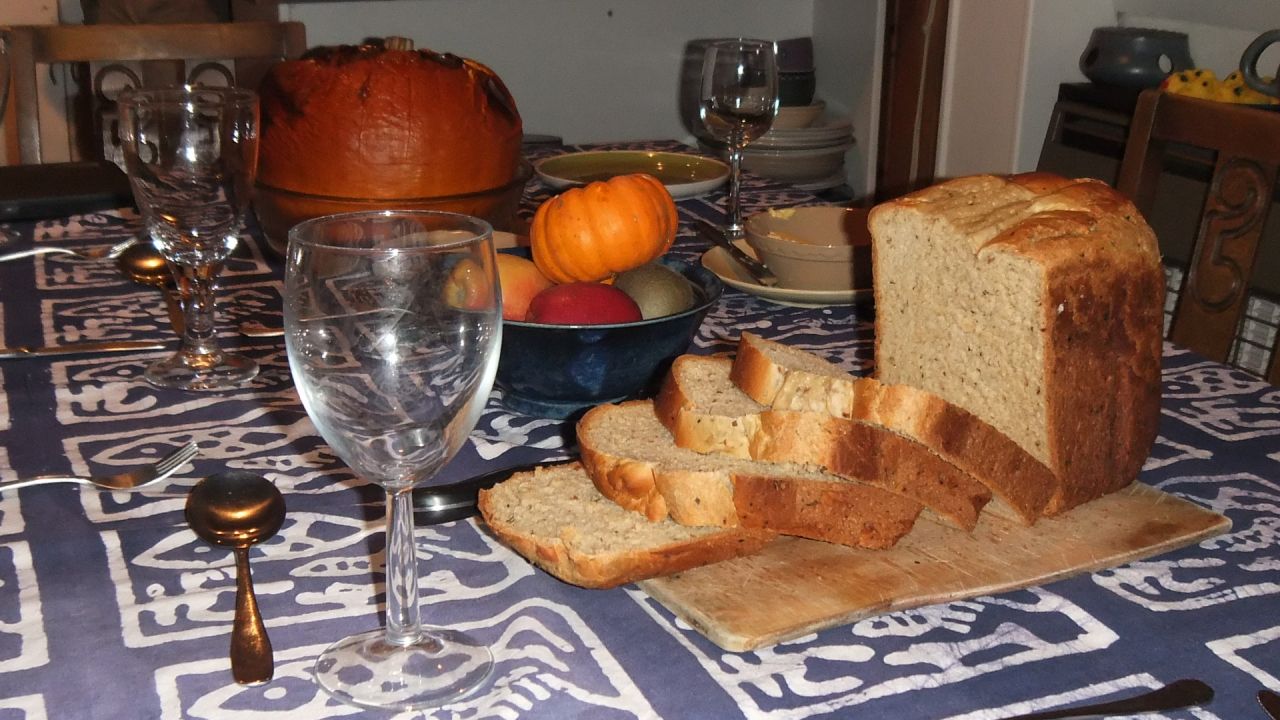
|
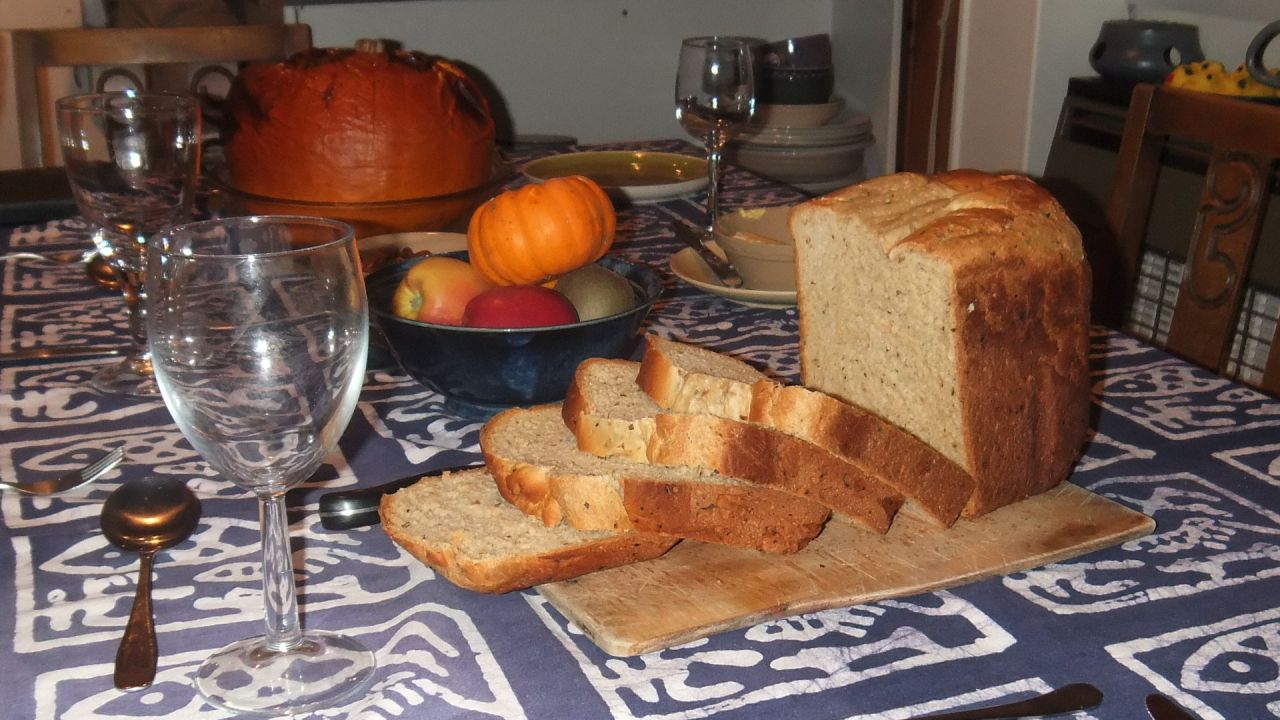
|
| • | • |
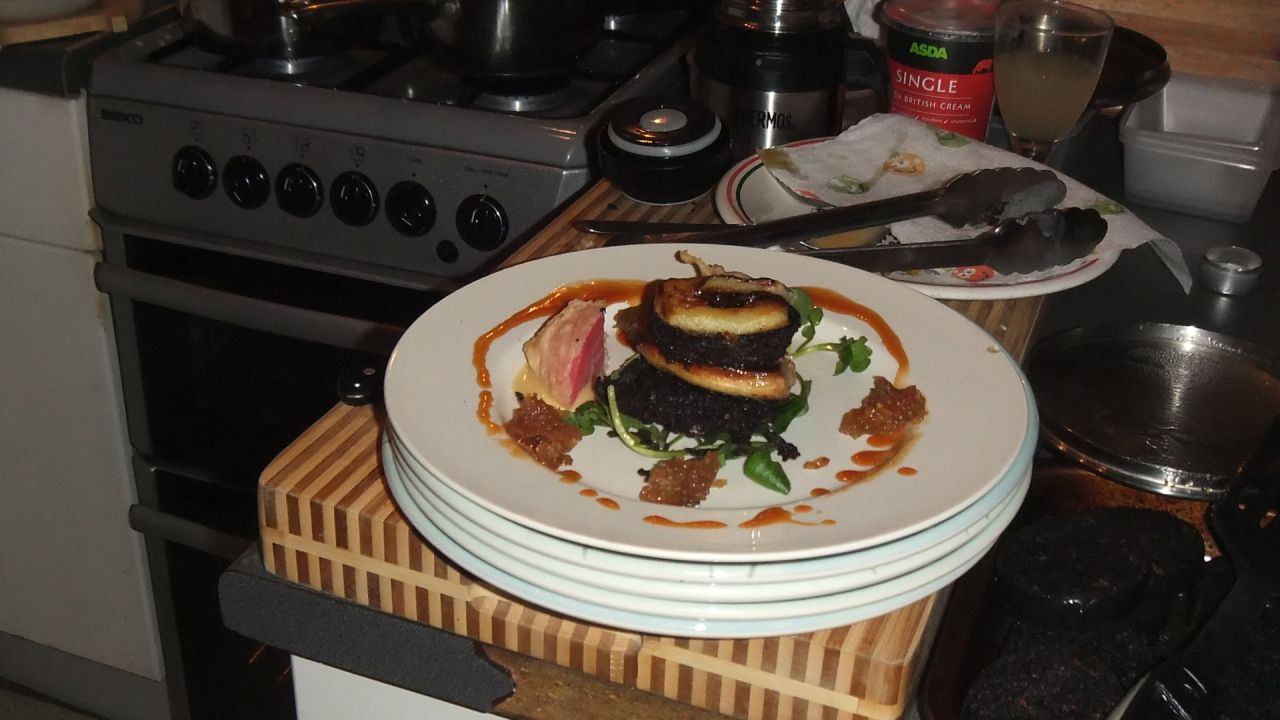
|
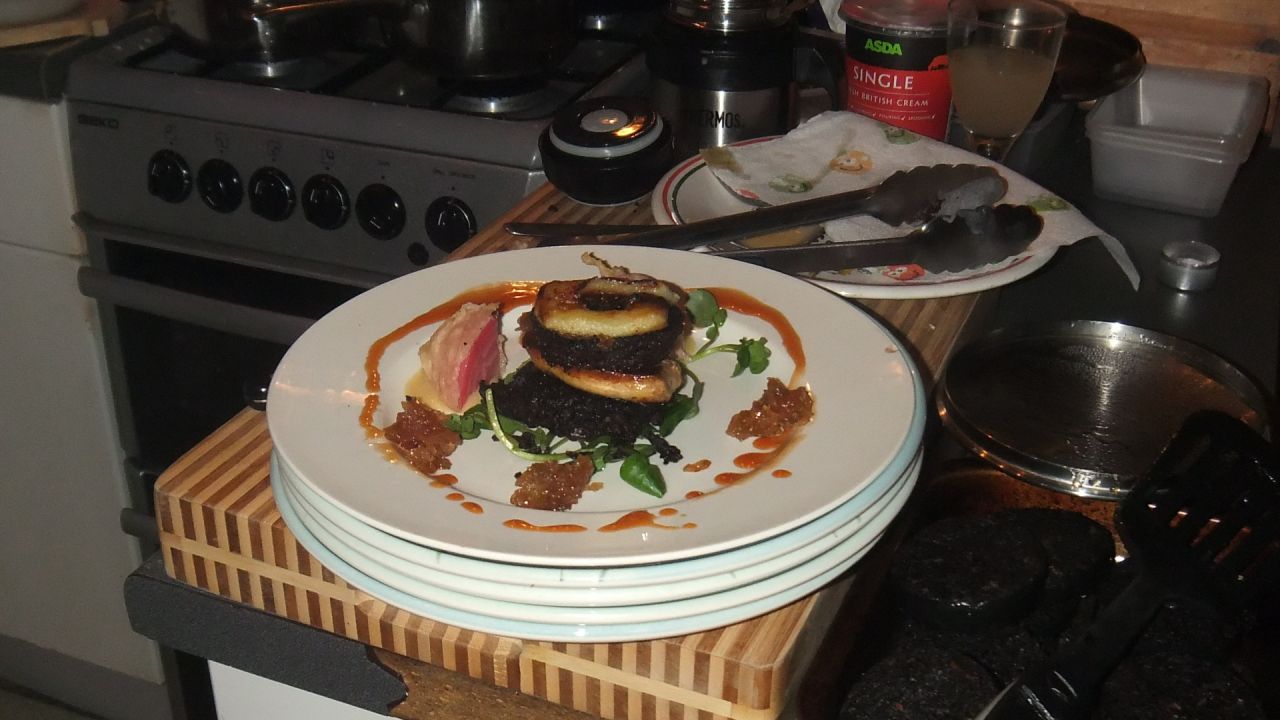
|
Braised Cabbage In Cider
side
Inspired by a Roux Brothers recipe
Serves 4
Ingredients
- 1 medium Savoy cabbage, about 1½lb (750g)
- drizzle of olive oil
- pinch or 3 of caraway seeds maybe juniper berries or cumin, onion or fennel seeds might work?
- 3½ oz (100g) thick smoked bacon slices, rind removed
- 7 oz (200g) shallots, peeled and left whole
- 1 granny smith, peeled, chopped
- 2 clove garlic, peeled and crushed
- 100ml (about ⅓ bottle) cider
- salt and freshly ground black pepper
Preparation
Pre-heat the oven to gas mark 6, 400°F (200°C).
Trim any coarse or damaged leaves from the cabbage, then cut it into quarters. Slice away the hard central stalk and shred the remaining cabbage into 1cm strips. Rinse in cold water and drain thoroughly in a colander.
Cut the bacon into 1cm strips.
Heat the olive oil in a heavy casserole and fry the caraway seeds until they release their aroma.
Add the sliced bacon and the shallots. Fry until the onions are starting to colour.
Meanwhile peel and core the apple and cut into 1cm cubes. Add to the pan with the crushed garlic.
When the apple has begun to caramelise, add the cabbage and stir around to coat with oil, then add the cider and bubble it off a little while you scrape the bottom of the pan.
Season with a little salt and some black pepper.
Serve hot.
Pre-heat the oven to gas mark 6, 400°F (200°C).
Trim any coarse or damaged leaves from the cabbage, then cut it into quarters. Slice away the hard central stalk and shred the remaining cabbage into 1cm strips. Rinse in cold water and drain thoroughly in a colander.
Cut the bacon into 1cm strips.
Heat the olive oil in a heavy casserole and fry the caraway seeds until they release their aroma.
Add the sliced bacon and the shallots. Fry until the onions are starting to colour.
Meanwhile peel and core the apple and cut into 1cm cubes. Add to the pan with the crushed garlic.
When the apple has begun to caramelise, add the cabbage and stir around to coat with oil, then add the cider and bubble it off a little while you scrape the bottom of the pan.
Season with a little salt and some black pepper.
You can pause at this stage if you don't need the cabbage just yet.
Just reheat it back up on the stove when you're ready to continue.
Put on the lid and transfer to the oven for about 30 minutes,
until the shallots and cabbage are tender.Serve hot.
Really good. Though the colour can be rather dull unless you pick nice dark cabbage.
Red Onion Bread with Thyme and Rosemary
bread veg
Thank God for bread machines!
I thinly sliced three red onions, threw in a tablespoon of chopped fresh rosemary, and gently caramelised them in a tablespoon or two of butter until golden and well reduced.
Then I mixed enough strong white flour to dry the mixture out so it wasn't too greasy looking, and added a tablespoon of roughly chopped thyme leaves.
Then I just followed my bread machine instructions for making Classic White Bread, and added my onion and herb mix when the machine angrily beeped at me demanding nuts, or raisins, or whatever you're supposed to add.
Despite mysteriously rising over-enthusiastically and sticking itself to the roof of the machine, spoiling the crust a bit, the bread was rather good.
I thinly sliced three red onions, threw in a tablespoon of chopped fresh rosemary, and gently caramelised them in a tablespoon or two of butter until golden and well reduced.
Then I mixed enough strong white flour to dry the mixture out so it wasn't too greasy looking, and added a tablespoon of roughly chopped thyme leaves.
Then I just followed my bread machine instructions for making Classic White Bread, and added my onion and herb mix when the machine angrily beeped at me demanding nuts, or raisins, or whatever you're supposed to add.
Despite mysteriously rising over-enthusiastically and sticking itself to the roof of the machine, spoiling the crust a bit, the bread was rather good.
Ingredients
- 3 red onions
- fresh herbs (rosemary, thyme)
- butter for frying
- extra flour for the onion mixture
For the bread:- scant 350ml milk
- 2 tbsp butter
- 1½ tsp salt
- 2 tbsp sugar
- 600g strong white flour
- 1 packet of dry yeast
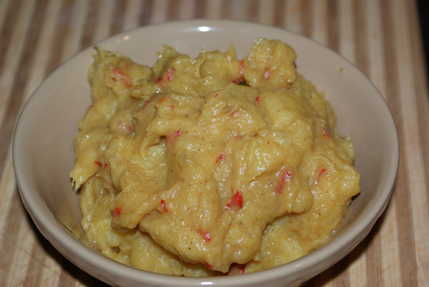
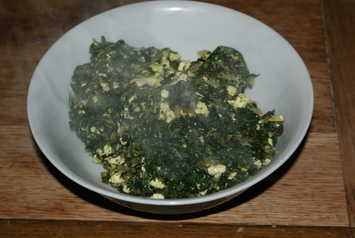
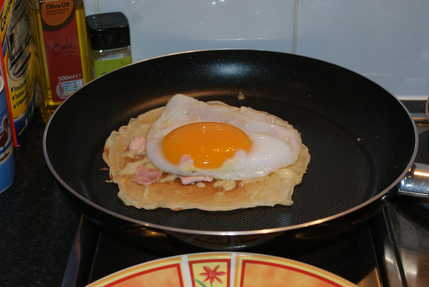
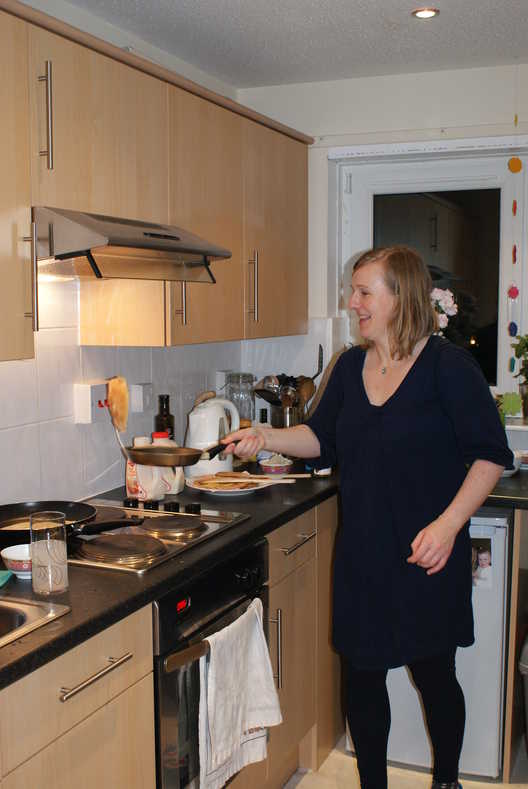
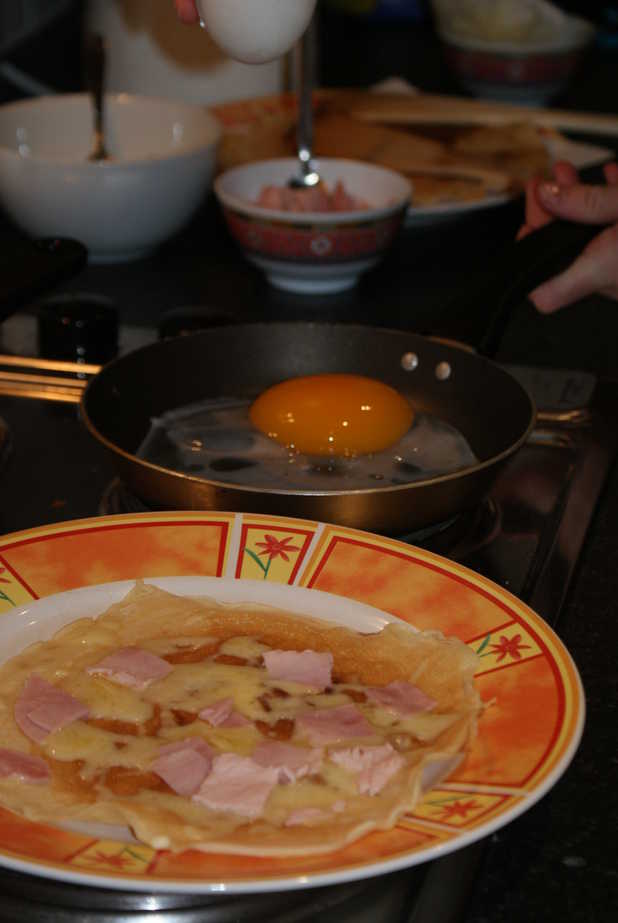
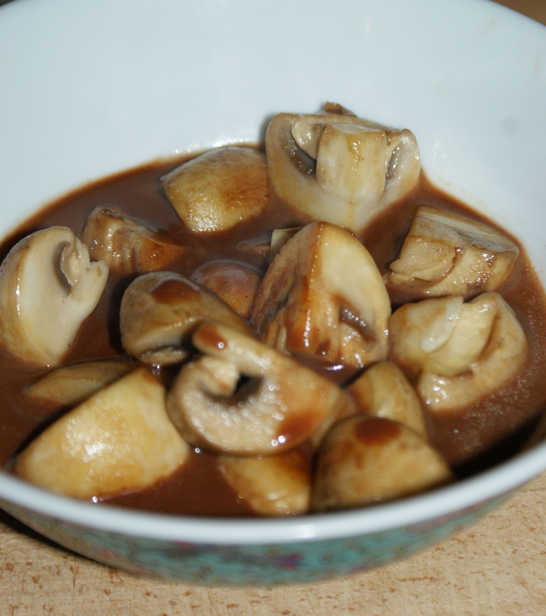

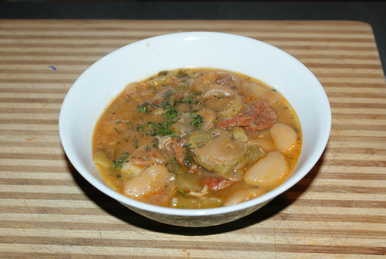
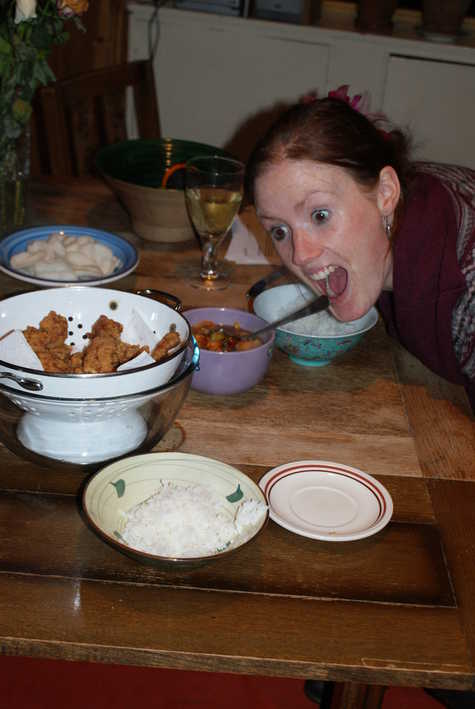
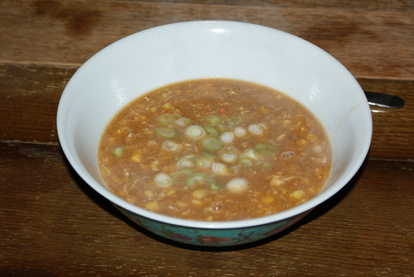

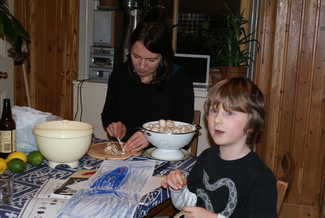
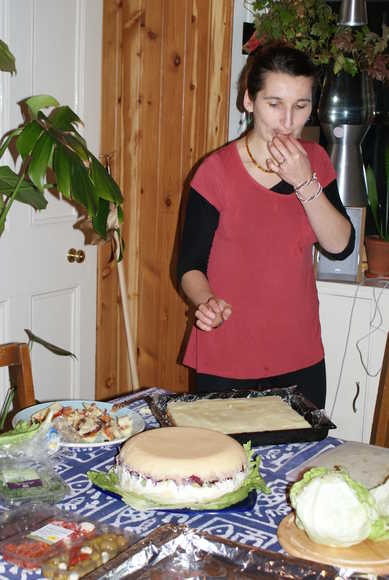
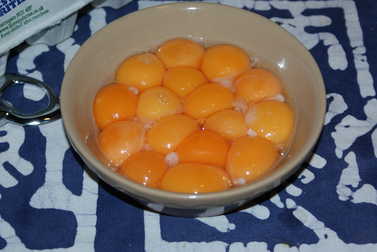


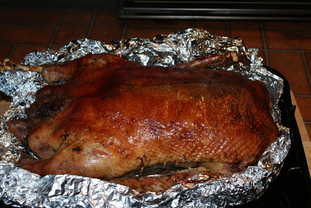



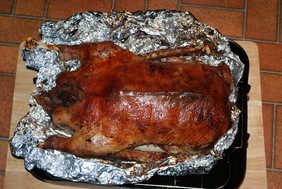
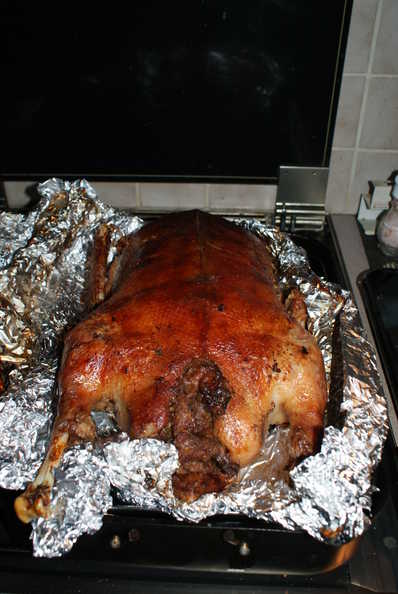

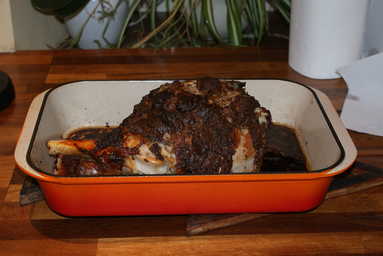

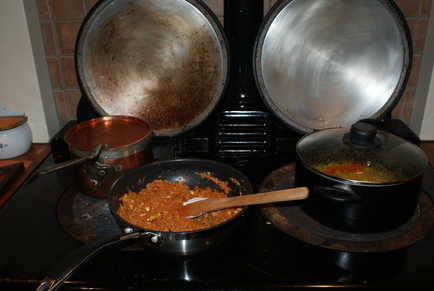
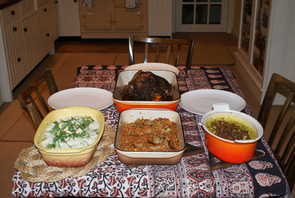
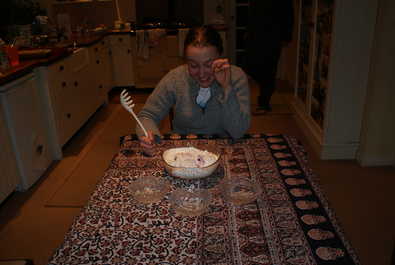
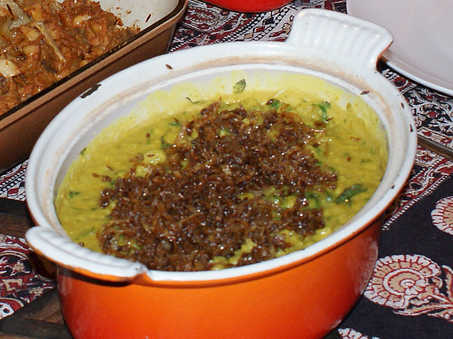
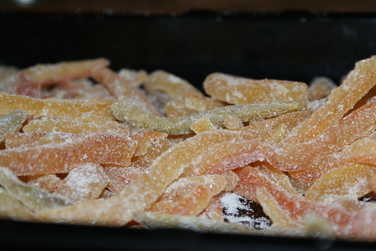
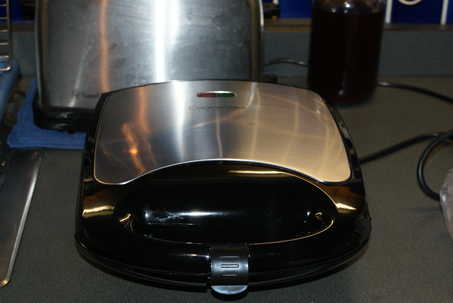
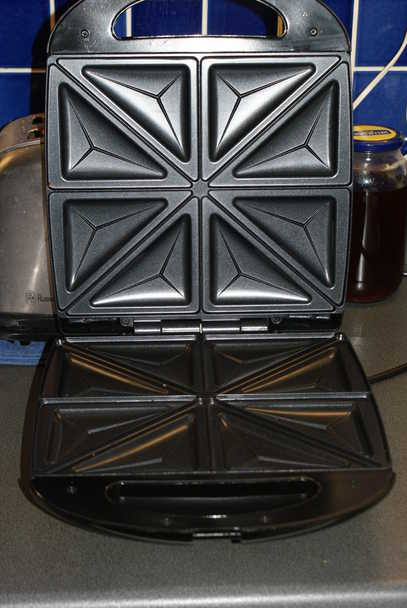
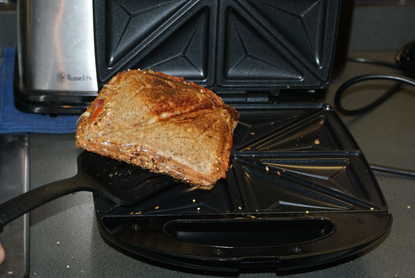
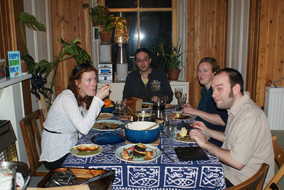
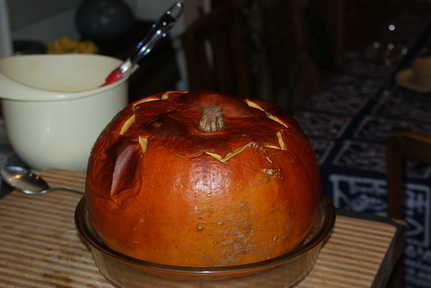
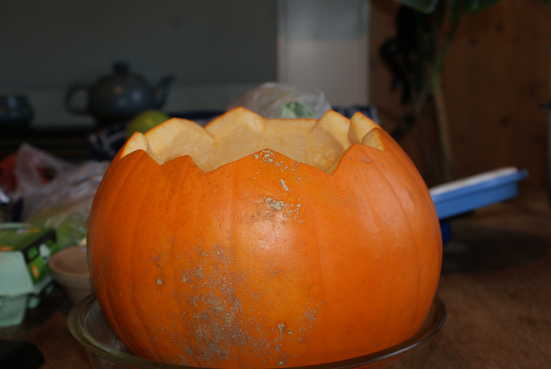
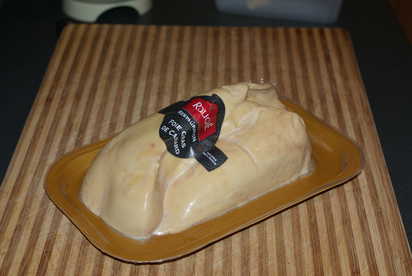
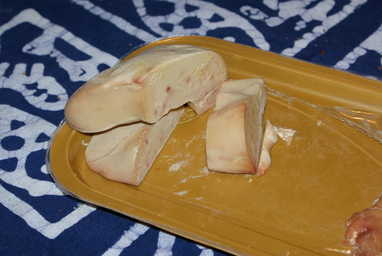
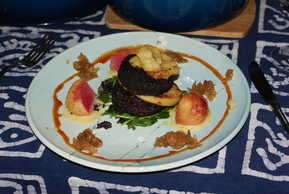
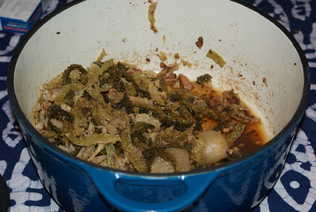
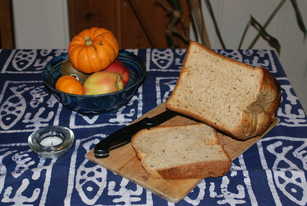
It was a bit too limey (maybe use half a lime) and not bananay enough. Perhaps wait for the bananas to ripen?